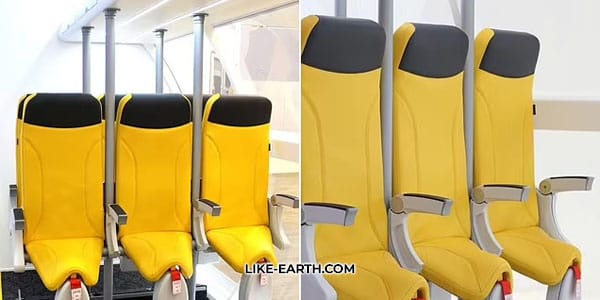Low-Cost Airlines to Launch Standing-Only Seats in 2026

Low-cost airlines to launch standing-only seats in 2026 has become one of the most talked-about aviation headlines this year. Budget airlines are preparing for a massive shift in how passengers experience short-haul flights — and not everyone is thrilled.
Sources confirm that several budget carriers across Europe and Asia are investing in the development of “vertical seating” or “standing-only” cabin designs. These radical new seats aim to accommodate more passengers, cut operational costs, and reduce ticket prices for the average flyer.
What Are Standing-Only Airline Seats?
Standing-only seats, also called “vertical seats,” are a new class of airline seat that allow passengers to stand upright while being secured by a padded backrest, arm support, and a seat belt harness. The design is intended for short flights, generally lasting under 90 minutes.
The idea isn’t entirely new. Companies like Aviointeriors have showcased prototype models at international aviation expos since 2010. However, 2026 could mark the first time these seats are actually rolled out on commercial flights.
The aviation design company Skyrider 3.0 has led the innovation. Their saddle-style design positions passengers semi-standing with minimal legroom, closely packed for space efficiency.
Which Airlines Are Participating?
While no official airline names have been released, insiders say several low-cost carriers — including some based in Ireland, Spain, and Southeast Asia — are preparing aircraft modifications. Ryanair, a frequent subject of bold aviation experimentation, is rumored to be exploring the model again after shelving a similar proposal years ago.
Asian airline carriers, known for embracing innovation in budget flying, are also reportedly involved in prototype testing and passenger safety evaluations.
Safety and Regulation Concerns
One of the major hurdles for the standing-only seat plan remains regulatory approval. Aviation authorities, such as the European Union Aviation Safety Agency (EASA) and the U.S. Federal Aviation Administration (FAA), require rigorous safety testing for all aircraft seating arrangements.
Passenger safety in turbulence and emergency landings is a top concern. While the seats include safety harnesses and padded areas, many aviation experts remain skeptical of their effectiveness under extreme flight conditions.
Airlines argue that these seats will only be used on very short flights, mostly under one hour. They emphasize that the vertical seat design is not intended to replace standard seating but to supplement it as a lower-cost option.
Public Reaction and Passenger Concerns
News that low-cost airlines to launch standing-only seats in 2026 sparked debate on social media. Reactions range from amusement to outrage. Some flyers see it as an acceptable trade-off for cheaper fares, while others question the dignity and comfort of standing during a flight.
“What’s next? Hanging from a strap like on a bus?” joked one user on X (formerly Twitter). Others worry about accessibility and fatigue, especially for older or physically challenged travelers.
Airline spokespersons assure that traditional seats will remain available, and the new format is optional. However, some industry analysts warn that such innovations could normalize discomfort if they prove profitable.
Potential Benefits for Budget Travelers
Despite the criticism, standing-only seats may offer practical advantages. These include:
- Lower ticket prices: More seats per flight mean reduced per-passenger cost.
- Eco-friendlier travel: Lower aircraft weight reduces fuel consumption.
- Faster boarding: Simpler design could allow quicker entry and exit.
- Increased availability: Extra capacity can relieve overbooked routes.
For short city hops and business day-trips, vertical seating could revolutionize cheap travel. Still, these potential benefits must be weighed against ethical and regulatory considerations.
Industry Experts Weigh In
Dr. Laura Simmons, an aviation analyst at FlightForward Research, says the development is “a natural extension of budget airline strategies.”
“These airlines profit by cutting out extras — legroom, meals, even seat assignments,” she explains. “Standing-only seating is just the next phase of extreme optimization.”
However, she adds a warning: “Airlines must tread carefully. Push too far, and public backlash could damage trust and loyalty.”
Vertical Seating History and Timeline
The concept of vertical seating dates back more than a decade. Here is a brief timeline of key events:
- 2010: Ryanair floated the idea publicly but did not proceed due to backlash.
- 2018: Aviointeriors showcased Skyrider 2.0 with updated ergonomics.
- 2022: European test flights explored feasibility and comfort surveys.
- 2025: Regulatory trials began with limited prototype testing in Italy.
- 2026: Launch expected on short-haul flights in Europe and Asia.
The rise of ultra-low-cost flying has made these experiments more appealing to airlines chasing profitability on tight margins.
How Will This Affect the Future of Flying?
If successful, standing-only seats could become standard for short-haul, high-traffic routes. The key factors to watch will be regulatory decisions, passenger feedback, and operational performance.
It could also trigger a ripple effect throughout the aviation sector. Traditional carriers may adopt similar methods or be forced to adapt pricing models to compete.
Consumer watchdog groups are already preparing to monitor how these changes affect passenger rights and safety.
Stay Updated with the Latest Travel News
For real-time updates and verified information, consider following this WhatsApp travel news channel for breaking aviation developments.
To explore more articles on travel innovation, sustainability, and global transport, visit our trusted partner Like Earth.
Conclusion
Low-cost airlines to launch standing-only seats in 2026 marks a major shift in how we define air travel. Whether you see it as visionary or ridiculous, one thing is clear — the skies are changing. With economic pressures pushing the limits of design and passenger expectations, we may be entering a new age of flight: upright, fast, and fiercely affordable.
Would you try standing-only seats for a cheaper flight? Share your thoughts and let us know how far you’d go to save on airfare.
Share This Article
Let your friends know about this exciting news!



